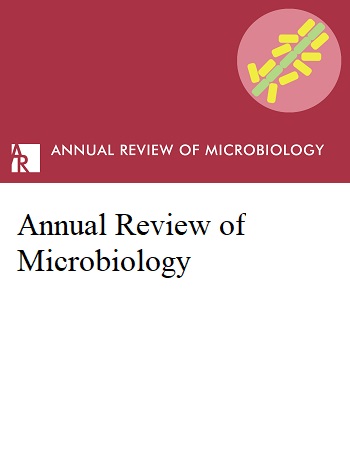由多样性产生的逆元素加速进化。
IF 9.9
1区 生物学
Q1 MICROBIOLOGY
引用次数: 8
摘要
产生多样性的逆转录酶元件(DGRs)通过促进配体结合蛋白结构域的快速进化,创造了大量靶向的功能多样性。在细菌、古菌及其各自的病毒中已经鉴定出数千个DGR。它们广泛分布在整个微生物世界,在某些分类群和环境中观察到富集。多样化机制通过一种称为诱变逆转录的新机制发挥作用,即核苷酸序列信息从不变的DNA模板重复序列(TR)复制到RNA中间体中,在cDNA合成过程中由DGR编码的逆转录酶在TR腺嘌呤处选择性诱变,并转移到可变蛋白基因内的可变重复序列(VR)区域(54)。这种单向信息流使TR-DNA序列未经修饰,从而允许重复几轮诱变逆转录以优化可变蛋白质功能。DGR靶基因通常是模块化的,并且可以编码一个或多个附加在可多样化配体结合基序上的各种离散功能结构域。细菌可变蛋白通常定位于细胞表面,尽管一个子集似乎是细胞质的,而噬菌体编码的DGR通常使尾纤维相关受体结合蛋白多样化。在这里,我们对这些独特有益的遗传元素加速蛋白质进化的机制和后果进行了全面的综述。《微生物学年度评论》第76卷预计最终在线出版日期为2022年9月。请参阅http://www.annualreviews.org/page/journal/pubdates用于修订估算。本文章由计算机程序翻译,如有差异,请以英文原文为准。
Accelerated Evolution by Diversity-Generating Retroelements.
Diversity-generating retroelements (DGRs) create vast amounts of targeted, functional diversity by facilitating the rapid evolution of ligand-binding protein domains. Thousands of DGRs have been identified in bacteria, archaea, and their respective viruses. They are broadly distributed throughout the microbial world, with enrichment observed in certain taxa and environments. The diversification machinery works through a novel mechanism termed mutagenic retrohoming, whereby nucleotide sequence information is copied from an invariant DNA template repeat (TR) into an RNA intermediate, selectively mutagenized at TR adenines during cDNA synthesis by a DGR-encoded reverse transcriptase, and transferred to a variable repeat (VR) region within a variable-protein gene (54). This unidirectional flow of information leaves TR-DNA sequences unmodified, allowing for repeated rounds of mutagenic retrohoming to optimize variable-protein function. DGR target genes are often modular and can encode one or more of a wide variety of discrete functional domains appended to a diversifiable ligand-binding motif. Bacterial variable proteins often localize to cell surfaces, although a subset appear to be cytoplasmic, while phage-encoded DGRs commonly diversify tail fiber-associated receptor-binding proteins. Here, we provide a comprehensive review of the mechanism and consequences of accelerated protein evolution by these unique and beneficial genetic elements. Expected final online publication date for the Annual Review of Microbiology, Volume 76 is September 2022. Please see http://www.annualreviews.org/page/journal/pubdates for revised estimates.
求助全文
通过发布文献求助,成功后即可免费获取论文全文。
去求助
来源期刊

Annual review of microbiology
生物-微生物学
CiteScore
18.10
自引率
0.00%
发文量
37
期刊介绍:
Annual Review of Microbiology is a Medical and Microbiology Journal and published by Annual Reviews Inc. The Annual Review of Microbiology, in publication since 1947, covers significant developments in the field of microbiology, encompassing bacteria, archaea, viruses, and unicellular eukaryotes. The current volume of this journal has been converted from gated to open access through Annual Reviews' Subscribe to Open program, with all articles published under a CC BY license. The Impact Factor of Annual Review of Microbiology is 10.242 (2024) Impact factor. The Annual Review of Microbiology Journal is Indexed with Pubmed, Scopus, UGC (University Grants Commission).
 求助内容:
求助内容: 应助结果提醒方式:
应助结果提醒方式:


